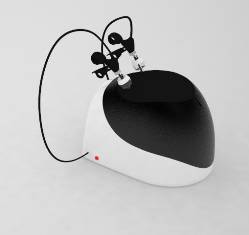Force feedback helps train surgeons in keyhole surgery
14 Feb 2011
The number of complications following keyhole surgery can be reduced by giving the surgeons a better feeling of how hard they are grasping the tissue with their operating instruments.
Delft University of Technology researcher Eleonora Westebring-van der Putten has developed a prototype instrument that sends haptic feedback signals to the surgeon through the handle.
Grasp force feedback
Keyhole surgery has rapidly gained in popularity in hospitals. An exploratory operation — known as a laparoscopy when carried out in the abdominal cavity — is generally less invasive for the patient, but calls for different manual skills than traditional open surgery. Training in these skills is therefore essential for the prevention of complications.
Problems with keyhole surgery partly arise because it is very difficult to gauge the force of the surgeon’s grasp. The surgeon is therefore less able to determine whether he or she is grasping the tissue too hard or too gently.
Industrial designer and human movement scientist Eleonora Westebring-van der Putten’s research is focused on the improvement of grasp control and the learning of the associated skills. The solution is to give the surgeon haptic feedback through the instrument. “Experiments have shown that augmented feedback on the grasp force is a good way for surgeons of all levels to gain a better command of gauging laparoscopic grasp force,” she said
Westebring has therefore developed a working prototype of a laparoscopic grasp instrument that gives augmented tangible feedback according to the amount of grasp force being applied.
“There are sensors in the tip of the instrument that measure how hard the surgeon is grasping. This information is fed back to the handle, which contains a cylinder that can turn in relation to the hand, as if something is falling out of your hand. In this way the cylinder indicates that the surgeon has too little grip, and is therefore grasping too gently.”
“The handle also contains vibrating elements, which start to vibrate if the surgeon is grasping too hard, while also taking account of how hard the surgeon is pulling. The harder he or she pulls on the tissue, the less hard he or she should grasp. We also take the type of tissue into account. After all, it makes quite a difference whether you are grasping an intestine or working with a liver.”

The prototype laparoscopic grasp trainer with
force feedback
Surgeon training
In the future an instrument such as Westebring’s could be used in training for real operations. “By training with feedback, surgeons learn to control their laparoscopic grasp force more quickly. The forces they apply are lower.” What is more, the effect seems to last. “When the feedback signal is removed, the surgeons can still carry out the procedure with reduced force. The feedback therefore helps with the control of the laparoscopic grasp force, even if it is only used in training.”